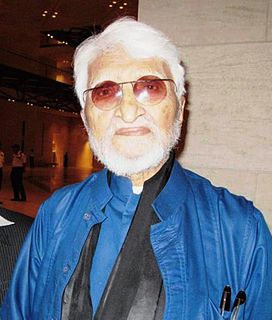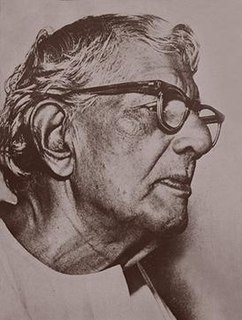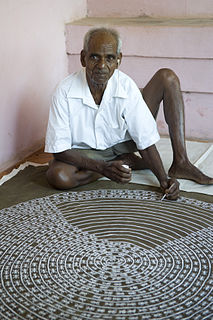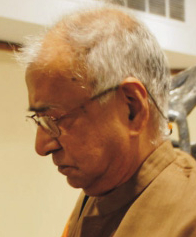
An apsaras or apsara is a type of female spirit of the clouds and waters in Hindu and Buddhist culture. They figure prominently in the sculpture, dance, literature and painting of many South Asian and Southeast Asian cultures. There are two types of apsaras: laukika (worldly) and daivika (divine). Urvasi, Menaka, Rambha, Tilottama and Ghritachi are the most famous among them.

Maqbool Fida Husain was an Indian artist known for executing bold, vibrantly coloured narrative paintings in a modified Cubist style. He was one of the most celebrated and internationally recognised Indian artists of the 20th century. He was one of the founding members of Bombay Progressive Artists' Group. M.F. Husain is associated with Indian modernism in the 1940s. His early association with the Bombay Progressive Artists' Group used modern technique, and was inspired by the "new" India after the partition of 1947. His narrative paintings, executed in a modified Cubist style, can be caustic and funny as well as serious and sombre. His themes—sometimes treated in series—include topics as diverse as Gandhi, Mother Teresa, the Ramayana, the Mahabharata, the British Raj, and motifs of Indian urban and rural life. In September 2020, his painting titled “Voices”, auctioned for a record $2.5 million.

Mughal painting is a particular style of South Asian, particularly North Indian, painting confined to miniatures either as book illustrations or as single works to be kept in albums (muraqqa). It emerged from Persian miniature painting and developed in the court of the Mughal Empire of the 16th to 18th centuries. Battles, legendary stories, hunting scenes, wildlife, royal life, mythology, as well as other subjects have all been frequently depicted in paintings.

Jamini Roy was an Indian painter. He was honoured with the State award of Padma Bhushan in 1954. He was one of the most famous pupils of Abanindranath Tagore, whose artistic originality and contribution to the emergence of art in India remains unquestionable.
Kripal Singh Shekhawat (1922-2008) was a renowned craftsman and ceramist of India. He was famous for his skills in Blue Pottery of Jaipur and is credited for the revival of that art in India.
Vasudeo S. Gaitonde (1924–2001) was regarded as one of India's foremost abstract painters. He received the Padma Shri Award in 1971.

Jivya Soma Mashe was an artist of the Maharashtra state in India, who popularised the Warli tribal art form.

Kalpathi Ganpathi "K.G." Subramanyan was an Indian artist. He was awarded the Padma Vibhushan in 2012.
Kalal Laxma Goud is an Indian painter, printmaker and draughtsman. He works in variety of mediums including etching, gouache, pastel, sculpture, and glass painting. He is best known for his early drawings that depict eroticism in a rural context, and also for the originality and quality of his etchings and aquatints.

Bhimsa, the Dancing Bear is a children's novel by Christine Weston. Set in contemporary India, it follows the adventures of two boys, David and Gopali, as they roam the country with a dancing bear. The first edition was illustrated by Roger Duvoisin. The novel was first published in 1945 and was a Newbery Honor recipient in 1946.

The Stranglers of Bombay is a 1959 British adventure horror film directed by Terence Fisher for Hammer Films dealing with the British East India Company's investigation of the cult of Thuggee stranglers in the 1830s. The film stars Guy Rolfe, Allan Cuthbertson and Andrew Cruickshank.

Patali Srikhetra is a famous place with significant historical importance for Subarnapur district and Odisha, India. This religious place is associated with Shaktism, Buddhism and Vaishnavism. It is located in the foot of Trikut Hill at Kotsamalai of the Birmaharajpur subdivision of Subarnapur district, Odisha, India. It widely believed that the idol of Lord Jagannath, Balabhadra and Devi Subhadra were kept hiding in the caves of the Trikut for a period of 144 years.
Gopali is a village situated in the Deoband Mandal, of Saharanpur District, Uttar Pradesh, India. The village 11.08 kilometres from its Mandal headquarters at Deoband.

Vijay Sharma is an Indian painter and art historian, known for his expertise in the Pahari school of miniature painting. He was honored by the Government of India, in 2012, with the fourth highest Indian civilian award of Padma Shri.
Krishn Kanhai, born on 21 August 1961, is an Indian artist and painter, specialist in portrait, realistic, contemporary paintings and on lord Radha-Krishna theme paintings. A Padmshri awardee, Kanhai is described as an artist with the midas touch.
Biren De (1926–2011) was an Indian painter of modern art, known for his paintings with tantric influences. His paintings were characterized by symmetrical patterns of geometry and the presence of tantric symbols such as mandala, phallus and vagina, reportedly representing masculine and feminine energies of the universe. The Government of India awarded him the fourth highest civilian honour of the Padma Shri in 1992.
Brijinder Nath Goswamy is an Indian art critic, art historian and a former vice chairman of the Sarabhai Foundation of Ahmedabad, which runs the Calico Museum of Textiles. Goswamy is best known for his scholarship on Pahari painting and Indian miniature paintings. He is the author of over 20 books on arts and culture, including Sakti Burman: A Private Universe, a monograph on the life and works of Sakti Burman, renowned Bengali painter and Masters of Indian Painting 1100-1900, a treatise on Indian miniature art. The Government of India awarded him the fourth highest civilian award of the Padma Shri in 1998 and followed it up with the third highest honour of the Padma Bhushan in 2008.
Gopali Youth Welfare Society, known as GYWS, is a government-registered non-governmental organization in West Bengal. It was founded in 2002 and registered under the West Bengal Societies Registration Act, 1961 on April 20, 2005. It is run by IIT Kharagpur students under the guidance of IIT Kharagpur professors and Gopali village residents. The main areas that GYWS focuses on are child education, women empowerment, and the abolition of child labor. It has launched a free education initiative, social awareness drives, and vocational training programs.

Gopali Khera is a village in Sareni block of Rae Bareli district, Uttar Pradesh, India. It is located 14 km from Lalganj, the tehsil headquarters. As of 2011, it has a population of 610 people, in 123 households. It has no healthcare facilities and does not host a weekly haat or a permanent market. It belongs to the nyaya panchayat of Sagar Khera.
Khandu Wangchuk Bhutia is an artist from the Sikkim State of India known for his exquisite creative works in the Thangka style of painting. Thangka is a Tibetan Buddhist painting on cotton, silk appliqué, usually depicting a Buddhist deity, scene, or mandala. Thangkas are traditionally kept unframed and rolled up when not on display, mounted on a textile backing somewhat in the style of Chinese scroll paintings, with a further silk cover on the front. Khandu Wangchuk Bhutia hails from Sakyong in West Sikkim and had his formal education from Government Senior Secondary School in Pelling and at Senior Secondary School at Namchi. After his formal education, he was ordained into monastic life at the Pemayangtse Monastery. In the monastery, he took up Thangka painting as a profession. He trained in Thangka painting under several renowned thangka painters like Dungzin Rimpoche, late Jigme Wangchuk Lama, late Phuntsok Sangpo and late Zapa Acho.










